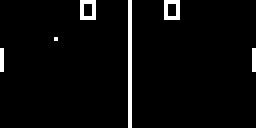 | ||
CHIP-8 is an interpreted programming language, developed by Joseph Weisbecker. It was initially used on the COSMAC VIP and Telmac 1800 8-bit microcomputers in the mid-1970s. CHIP-8 programs are run on a CHIP-8 virtual machine. It was made to allow video games to be more easily programmed for said computers.
Contents
- CHIP 8 applications
- CHIP 8 today
- Memory
- Registers
- The stack
- Timers
- Input
- Graphics and sound
- Opcode table
- References
Roughly twenty years after CHIP-8 was introduced, derived interpreters appeared for some models of graphing calculators (from the late 1980s onward, these handheld devices in many ways have more computing power than most mid-1970s microcomputers for hobbyists).
An active community of users and developers existed in the late 1970s, beginning with ARESCO's "VIPer" newsletter whose first three issues revealed the machine code behind the CHIP-8 interpreter.
CHIP-8 applications
There are a number of classic video games ported to CHIP-8, such as Pong, Space Invaders, Tetris, and Pac-Man. There's also a random maze generator available. These programs are reportedly placed in the public domain, and can be easily found on the Internet.
CHIP-8 today
There is a CHIP-8 implementation for almost every platform, as well as some development tools. Despite this, there are only a small number of games for the CHIP-8.
CHIP-8 has a descendant called SCHIP (Super Chip), introduced by Erik Bryntse. In 1990, a CHIP-8 interpreter called CHIP-48 was made for HP-48 graphing calculators so that games could be programmed more easily. Its extensions to CHIP-8 are what became known as SCHIP. It features a larger resolution and several additional opcodes which make programming easier. If it were not for the development of the CHIP-48 interpreter, CHIP-8 would not be as well known today.
The next most influential developments (which popularized S/CHIP-8 on many other platforms) were David Winter's emulator, disassembler, and extended technical documentation. It laid out a complete list of undocumented opcodes and features, and was distributed across many hobbyist forums. Many emulators had these works as a starting point.
While CHIP-8 and SCHIP have commonly been implemented as emulators, a pure hardware implementation (written in the Verilog language) also exists for certain FPGA boards.
Memory
CHIP-8 was most commonly implemented on 4K systems, such as the Cosmac VIP and the Telmac 1800. These machines had 4096 (0x1000) memory locations, all of which are 8 bits (a byte) which is where the term CHIP-8 originated. However, the CHIP-8 interpreter itself occupies the first 512 bytes of the memory space on these machines. For this reason, most programs written for the original system begin at memory location 512 (0x200) and do not access any of the memory below the location 512 (0x200). The uppermost 256 bytes (0xF00-0xFFF) are reserved for display refresh, and the 96 bytes below that (0xEA0-0xEFF) were reserved for call stack, internal use, and other variables.
In modern CHIP-8 implementations, where the interpreter is running natively outside the 4K memory space, there is no need for any of the lower 512 bytes memory space to be used, but it is common to store font data in those lower 512 bytes (0x000-0x200).
Registers
CHIP-8 has 16 8-bit data registers named from V0 to VF. The VF register doubles as a flag for some instructions, thus should avoid using. In addition operation VF is for carry flag. While in subtraction, it is the "not borrow" flag. In the draw instruction the VF is set upon pixel collision.
The address register, which is named I, is 16 bits wide and is used with several opcodes that involve memory operations.
The stack
The stack is only used to store return addresses when subroutines are called. The original 1802 version allocated 48 bytes for up to 12 levels of nesting; modern implementations normally have at least 16 levels.
Timers
CHIP-8 has two timers. They both count down at 60 hertz, until they reach 0.
Input
Input is done with a hex keyboard that has 16 keys which range from 0 to F. The '8', '4', '6', and '2' keys are typically used for directional input. Three opcodes are used to detect input. One skips an instruction if a specific key is pressed, while another does the same if a specific key is not pressed. The third waits for a key press, and then stores it in one of the data registers.
Graphics and sound
Original CHIP-8 Display resolution is 64×32 pixels, and color is monochrome. Graphics are drawn to the screen solely by drawing sprites, which are 8 pixels wide and may be from 1 to 15 pixels in height. Sprite pixels that are set flip the color of the corresponding screen pixel, while unset sprite pixels do nothing. The carry flag (VF) is set to 1 if any screen pixels are flipped from set to unset when a sprite is drawn and set to 0 otherwise. This is used for collision detection.
As previously described, a beeping sound is played when the value of the sound timer is nonzero.
Opcode table
CHIP-8 has 35 opcodes, which are all two bytes long and stored big-endian. The opcodes are listed below, in hexadecimal and with the following symbols:
